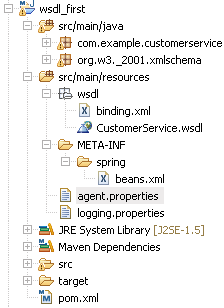Prepare the sample
Reuse the sample from .
In , in order to use the Service Locator, you needed to add a LocatorFeature. This time, you need to add "org.talend.esb.sam.agent.feature.EventFeature".
To do this, use a Spring configuration. The simplest way is to copy the "beans.xml" from examples/talend/tesb/sam/sam-example-osgi to src/main/resources/META-INF/spring/beans.xml of this project. Below are the main contents:
<import resource="classpath:META-INF/cxf/cxf.xml"/>
<import resource="classpath:META-INF/tesb/agent-context.xml"/>
<context:annotation-config/>
<bean
class="org.springframework.beans.factory.config.PropertyPlaceholderConfigurer">
<property name="ignoreUnresolvablePlaceholders" value="true"/>
<property name="location" value="classpath:agent.properties"/>
</bean>
<bean id="eventFeature" class="org.talend.esb.sam.agent.feature.EventFeature">
<property name="mapper" ref="eventMapper"/>
<property name="eventSender" ref="eventCollector"/>
<property name="logMessageContent" value="${log.messageContent}"/>
</bean>
<bean id="eventMapper"
class="org.talend.esb.sam.agent.eventproducer.MessageToEventMapperImpl">
<property name="maxContentLength" value="${log.maxContentLength}"/>
</bean>
<bean id="eventCollector"
class="org.talend.esb.sam.agent.collector.EventCollectorImpl" >
<!-- Default interval for scheduler. Start every X millis a new scheduler -->
<property name="defaultInterval" value="${collector.scheduler.interval}"/>
<!-- Number of events within one service call. This is a maximum number.
If there are events in the queue, the events will be processed. -->
<property name="eventsPerMessageCall" value="${collector.maxEventsPerCall}"/>
<property name="monitoringServiceClient" ref="monitoringServceV1Wrapper"/>
<property name="executor" ref="defaultExecutor"/>
<property name="scheduler" ref="defaultScheduler"/>
</bean>
<bean id="memoryQueue" class="java.util.concurrent.ConcurrentLinkedQueue"/>
<task:scheduler id="defaultScheduler" pool-size="2"/>
<task:executor id="defaultExecutor" pool-size="10"/>
<bean id="monitoringServceV1Wrapper"
class="org.talend.esb.sam.agent.serviceclient.MonitoringServiceWrapper">
<property name="monitoringService" ref="monitoringServiceV1Client"/>
<!-- Number of retries Default: 5 -->
<property name="numberOfRetries" value="${service.retry.number}"/>
<!-- Delay in milliseconds between the next attemp to send.
Thread is blocked during this time. Default: 1000 -->
<property name="delayBetweenRetry" value="${service.retry.delay}"/>
</bean>
<bean id="fixedProperties"
class="org.talend.esb.sam.common.handler.impl.CustomInfoHandler">
<property name="customInfo">
<map>
<entry key="Application name" value="Service2"/>
</map>
</property>
</bean>
<jaxws:client id="customerService" address="/CustomerServicePort"
implementor="com.example.customerservice.CustomerServiceImpl">
<jaxws:features>
<ref bean="eventFeature"/>
</jaxws:features>
</jaxws:client>And you also need to give an agent.properties file used to configure sam-agent:
collector.scheduler.interval=500
collector.maxEventsPerCall=10
log.messageContent=true
log.maxContentLength=-1
service.url=http://localhost:8040/services/MonitoringServiceSOAP
service.retry.number=3
service.retry.delay=5000You can give a logging.properties file for logger:
handlers = java.util.logging.ConsoleHandler, java.util.logging.FileHandler
# Set the default logging level for the root logger
.level = INFO
# Set the default logging level for new ConsoleHandler instances
java.util.logging.ConsoleHandler.level = INFO
# Set the default logging level for new FileHandler instances
java.util.logging.FileHandler.level = ALL
# Set the default formatter for new ConsoleHandler instances
#java.util.logging.ConsoleHandler.formatter = java.util.logging.SimpleFormatter
java.util.logging.ConsoleHandler.formatter = //
org.sopera.monitoring.util.CustomLogFormatter
# Set the default logging level for the logger named com.mycompany
#org.talend.esb.sam.level = FINE
#org.eclipse.persistence.level = INFO
org.talend.esb.sam.level = FINE
org.eclipse.persistence.level = WARNINGYou also need to change pom.xml to add more dependencies and plugins:
Add a dependency for sam-agent:
<dependency>
<groupId>org.talend.esb</groupId>
<artifactId>sam-agent</artifactId>
<version></version>
</dependency>Change the configuration of maven-bundle-plugin as following:
<plugin>
<groupId>org.apache.felix</groupId>
<artifactId>maven-bundle-plugin</artifactId>
<extensions>true</extensions>
<version>2.3.7</version>
<configuration>
<instructions>
<Bundle-SymbolicName>
${pom.groupId}.${pom.artifactId}
</Bundle-SymbolicName>
<Bundle-Name>${pom.name}</Bundle-Name>
<Bundle-Version>${pom.version}</Bundle-Version>
<Export-Package>
com.example.customerservice
</Export-Package>
<Bundle-Activator>
com.example.customerservice.Activator
</Bundle-Activator>
<Require-Bundle>
org.apache.cxf.bundle;version="",
org.apache.cxf.bundle,
org.springframework.beans,
org.springframework.context,
sam-agent
</Require-Bundle>
</instructions>
</configuration>
</plugin>Now the project structure is:

The configuration is finished, now install and deploy it into the OSGi Container, as described in previous chapters.
Did this page help you?
If you find any issues with this page or its content – a typo, a missing step, or a technical error – let us know how we can improve!
